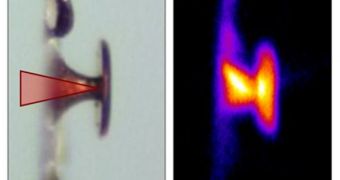One of the newest areas of research in science today is laser-particle acceleration, a phenomenon that is believed to be of great promise for modern cancer radiotherapy methods. Various energy ranges need to be achieved, in order for the LPA to be effective against specific types of cancer. Just recently, experts at the Forschungszentrum Dresden-Rossendorf (FZD), in Germany, managed to accelerate protons at the highest energy to date, just enough to make the resulting beams fitted for eye surgery.
According to AlphaGalileo, the lasers that are used in these scientific methods were selected as the best possible option for making protons move faster, because, otherwise, the scientists would have had to use large-scale particle accelerators. That would have been both too expensive and impractical, and would have posed severe limitations to the research teams that did not have very large budgets. In addition to the FZD team, investigators at the Sandia National Laboratories, the University of Nevada in Reno, the University of Missouri, Columbia, and the Los Alamos National Laboratory (LANL) in New Mexico, the US, also participated.
The experts managed to use the laser facilities at their respective institutions to accelerate protons until they reached an energy level of about 67.5 mega-electron volts (MeV). For comparison, an electron volt is the kinetic energy obtained when accelerating a particle with one volt. The amazingly powerful laser fires up in extremely short pulses, of around 600 femtoseconds. A single femtosecond equals the billionth part of a second. For example, the fastest chemical reaction in the world – the retinal pigments' reaction to light inside the eye – takes about 200 femtoseconds to happen.
The new measurements will be presented at the 51st Annual Meeting of the American Physical Society's Division of Plasma Physics, held between November 2-6 in Atlanta, Georgia. There is still some work to be done on the data, the experts admit, especially in determining the precise nature of the interactions that appear between the laser pulse and the protons when they meet. FZD PhD student Thomas Kluge has already developed a computer model that does a fairly accurate job in this respect, but it needs a bit more tweaking.

 14 DAY TRIAL //
14 DAY TRIAL //